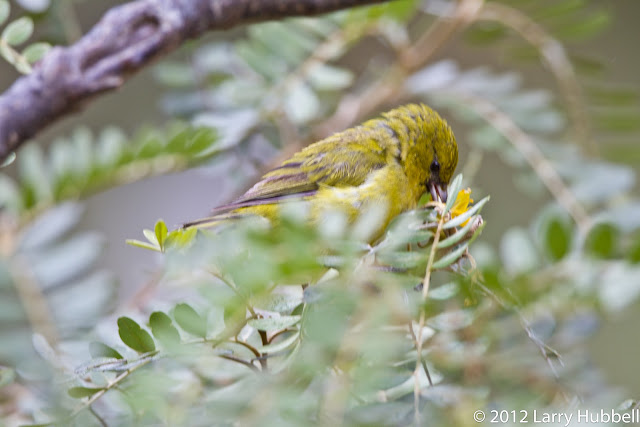The native Hawaiian flora and fauna has been in many cases squeezed out of existence or in the best case out of the prime locations. High on the side of Haleakala (an active though currently dormant volcano) exists a relatively small preserve containing a remnant of native forest and creatures. This preserve is just below the Haleakala National Park and while owned by the Haleakala Ranch it is managed by The Nature Conservancy. Entry is limited. The entire preserve is fenced in an attempt to keep out non-native mammals like goats, pigs and even cows that can literally consume the native vegetation. The entry of humans is also limited to those with a proper permit and a guide who:
- Checks their boots for non-native plant seeds,
- Keeps visitors on the designated path and
- Teaches them about the exotic and unique lifeforms they encounter.
My guide was Chuck Probst one of the few people on the planet who can identify native Hawaiian birds by their calls.
Even before entering the preserve Chuck found two of the endangered Nene geese.
All other endemic species of Hawaiian geese are now extinct.
Upon entering the preserve one is initially greeted with a forest of non-native trees that originated in North America, Japan and Australia. These were introduced in the previous century after the native forest in this area was destroyed. Chuck would like to see native trees and plants reintroduced to replace these non-native pines, cedars, spruce and eucalyptus trees.
Even in this area some of the native birds can be seen. This bird is the endangered I'iwi which is pronounced "E'e'vee"
Its red-orange beak is specially adapted to fit into the flower of a plant that may now be even more rare than the bird. As one progresses deeper into the preserve the non-native vegetation is left behind.
If one were to leave the designated path it would be easy to become lost in this ancient and primeval forest.
The farther one progresses into the native forest the more birds one hears. The thick forest is generally covered in clouds and relatively dim. It is far easier to hear the birds than it is to see them. The birds are wary and seldom approach very close but they have so little contact with humans that they do not seem at all scared or nervous. The I'iwi seems mostly curious as we approach.
The birds keep a safe distance but when they fly it appears that it is simply to get to the next blossom, bug or branch.
One of the most common native birds is the Apapane. At first glance it appears similar to the I'iwi, however the shorter and darker beak, the white rump and the longer tail are actually clearly distinctive.
An immature Apapane has yet to develop all of its color and it appears curious as well. Here is another shot of an immature Apapane with its tongue stuck out. That is a tongue that can get to those hard to reach spots in the flower.
The Maui Alauahio or Maui Creeper is somewhat easier to see in the forest since it is not feeding on the flowers in the tree tops but rather "creeping" up or down the trunks and branches of the trees looking for its food.
The immature creeper also seems to have a bit of curiosity.
The most rare and endangered bird spotted was the Akohekohe. There may be as few as 3000 of these birds left and they all exist either in or near this preserve. This crested honeycreeper is incredibly unique.
Here is the same bird feeding. Now the white crest is hidden but more of the red-orange on the back of the head is visible.The most rare and endangered bird spotted was the Akohekohe. There may be as few as 3000 of these birds left and they all exist either in or near this preserve. This crested honeycreeper is incredibly unique.
The last bird seen on this trip was a young Amakihi.
An expedition into the Waikamoi Preserve is a memory to treasure for a lifetime.
http://www.nature.org/ourinitiatives/regions/northamerica/unitedstates/hawaii/placesweprotect/waikamoi.xml
Larry
Odds and Ends:
To those of you in Madison Park near Eva and Alberts nest, Would you please keep an eye on the eaglets? If you spot them sitting on the side of the nest and flapping their wings like they are getting ready to fly please add a comment on this blog. In my absence Doug Schurman has graciously agreed to try and photograph the eaglets in flight. However since he has many other responsibilities it would be helpful if we can all work together and help optimize the time he has available. Thank you!!!

















Thanks for the pictures, I loved the shot of the scarlet I'iwi.
ReplyDeleteGreat report, Larry. Thanks for taking us along.
ReplyDelete